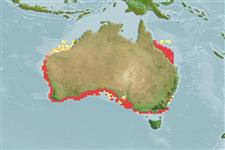Common names from other countries
>
Clupeiformes (Herrings) >
Spratelloididae (Small round herrings)
Etymology: Spratelloides: Old German, sprotte (1611) = a small fish, Clupea sp. + Greek, suffix, oides = similar to (Ref. 45335).
More on author: Ogilby.
Issue
The species in the genera Spratelloides Bleeker, 1851 and Jenkinsia Jordan & Evermann, 1896 should most probably be assigned to a separated family from Clupeidae and Dussumieriidae (Lavoué, pers. comm., July 2013). See a preliminary analysis in Lavoué et al. (2013: Ref. 93878).
Environment: milieu / climate zone / depth range / distribution range
экология
морской; солоноватоводный; пределы глубины 0 - 50 m (Ref. 188). Subtropical; 17°S - 39°S, 112°E - 152°E (Ref. 188)
Eastern Indian Ocean: southern Australia, from Dampier Archipelago, Western Australia to southern Queensland, including Tasmania.
Size / Вес / Возраст
Maturity: Lm ? range ? - ? cm
Max length : 12.0 cm SL самец/пол неопределен; (Ref. 33617)
колючие лучи спинного плавника (общее число): 0; членистые (мягкие) лучи спинного плавника (общее число): 10-14; колючие лучи анального плавника 0; членистые (мягкие) лучи анального плавника: 9 - 14; позвонки: 46 - 47. No teeth on maxilla, triangular premaxillae, 2 supra-maxillae, second supra-maxilla symmetrical; scale striae meeting at center; toothed posterior margin to scales, pre-dorsal scales 13 to 16; W-shaped pelvic scute.
Usually inshore schooling fishes (Ref. 188). Occurs in midwater in bays, inlets and coastal waters (Ref. 9563). Also often found around shallow offshore reefs (Ref. 33617).
Life cycle and mating behavior
половая зрелость | размножение | нерест | икра | Fecundity | личинки
Whitehead, P.J.P., 1985. FAO Species Catalogue. Vol. 7. Clupeoid fishes of the world (suborder Clupeoidei). An annotated and illustrated catalogue of the herrings, sardines, pilchards, sprats, shads, anchovies and wolf-herrings. FAO Fish. Synop. 125(7/1):1-303. Rome: FAO. (Ref. 188)
Статус Красного Списка МСОП (Ref. 130435)
CITES (Ref. 128078)
Not Evaluated
Угроза для людей
Harmless
Использование человеком
рыболовство: не имеет хозяйственного значения; наживка: usually
дополнительная информация
ссылкиаквакультура (рыбоводство)особенности рыбоводствастепень растяжениягенетикаElectrophoresesнаследуемостьболезниобработкаMass conversion
соавторыизображенияStamps, Coins Misc.звукиCiguateraскоростьтип плаванияжаберная областьOtolithsмозгзрение
инструменты
Специальные отчеты
Скачать в формате XML
ресурсы в Интернет
Estimates based on models
Preferred temperature (Ref.
115969): 15.5 - 27, mean 22.9 (based on 224 cells).
Phylogenetic diversity index (Ref.
82804): PD
50 = 0.5625 [Uniqueness, from 0.5 = low to 2.0 = high].
Bayesian length-weight: a=0.00389 (0.00180 - 0.00842), b=3.12 (2.94 - 3.30), in cm Total Length, based on all LWR estimates for this body shape (Ref.
93245).
Trophic level (Ref.
69278): 3.4 ±0.45 se; based on food items.
устойчивость к внешним воздействиям (Ref.
120179): высокий, минимальное время удвоения популяции до 15 месяцев (Preliminary K or Fecundity.).
Fishing Vulnerability (Ref.
59153): Low vulnerability (10 of 100).
